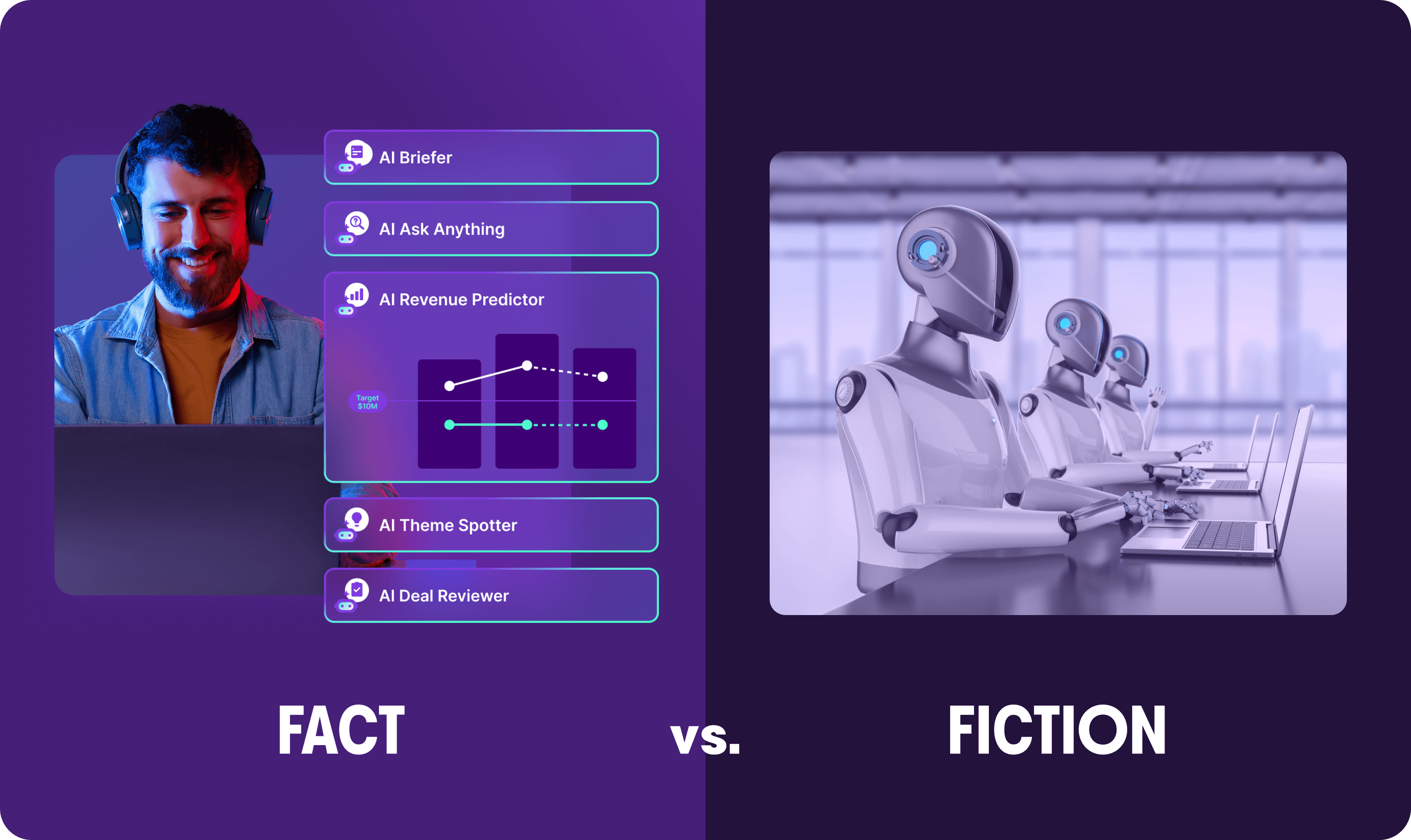Sales engagement
The 11 best discovery call tips you'll read this year

Chris Orlob
Content Author
Published on: March 27, 2019

In the Gong Labs series, you get insanely great sales tips from our AI-driven research into sales conversations. Subscribe here.
Are you looking to set your discovery calls on FIRE? 🔥
Well, this might be the most important thing you’ll read this year.
You’ll see why in a minute.
But First… A Disclaimer:
These tips are NOT for beginners.
You have to know the basics of good discovery for these to work. If you don’t, you’ll misapply them.
If you DO know the basics, these tips will take you to the next level.
With that said, let me jump right in and show you the first tip…
ONE: Discovery is a process, not an event
It’s not a STAGE during the sales cycle. It’s an ongoing process.
Your buyer’s situation is in flux. If you do “set it and forget it” discovery, your deal will go off the rails.
Right under your nose.
Bad salespeople treat discovery as a “check the box” event.
They have a standard list of questions. They ask them as if they’re working their way through a checklist.
This chart illustrates that:

You can see that AVERAGE reps ask all their questions at the beginning of the call.
They frontload discovery. It’s as if they’re completing a to-do list of questions before launching into their pitch.
To them, discovery is a static event.
The top performers spread their questions evenly across the call. To them, discovery is an ongoing process, not an event.
I couldn’t have said it better than this (it’s worth printing out):
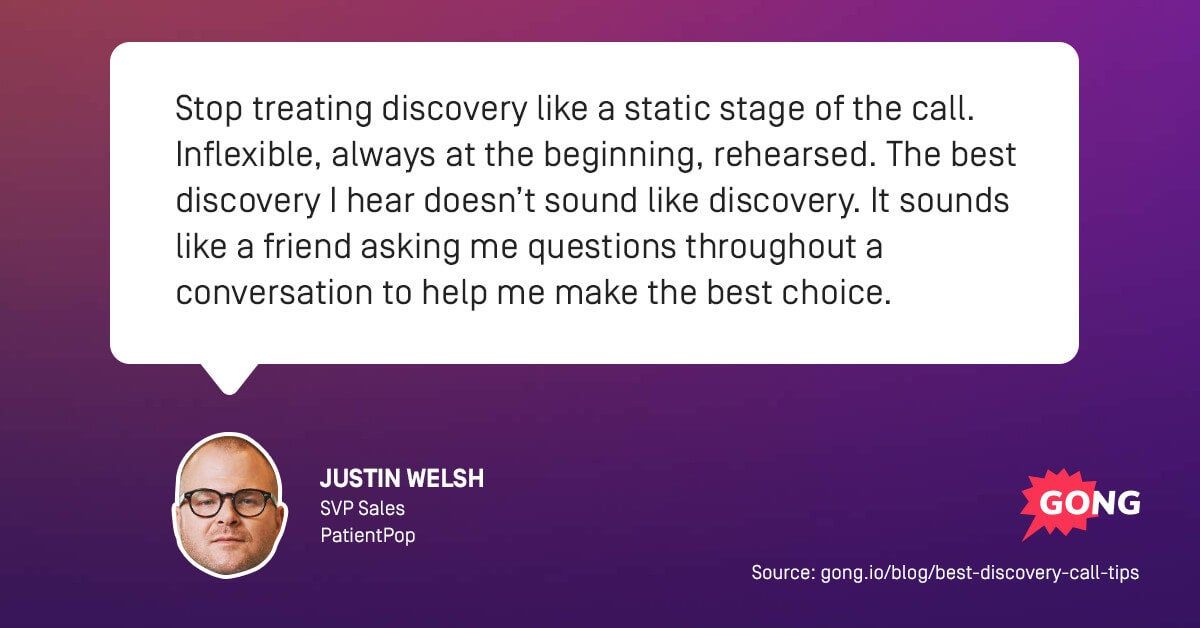
The best discovery doesn’t sound like discovery.
Take notes.
When you “get” discovery is a process (not an event), the natural implication is for you to…
TWO: Match your questions to the buyer’s journey
Your first few questions should respect your prospect’s stage in the buying journey.
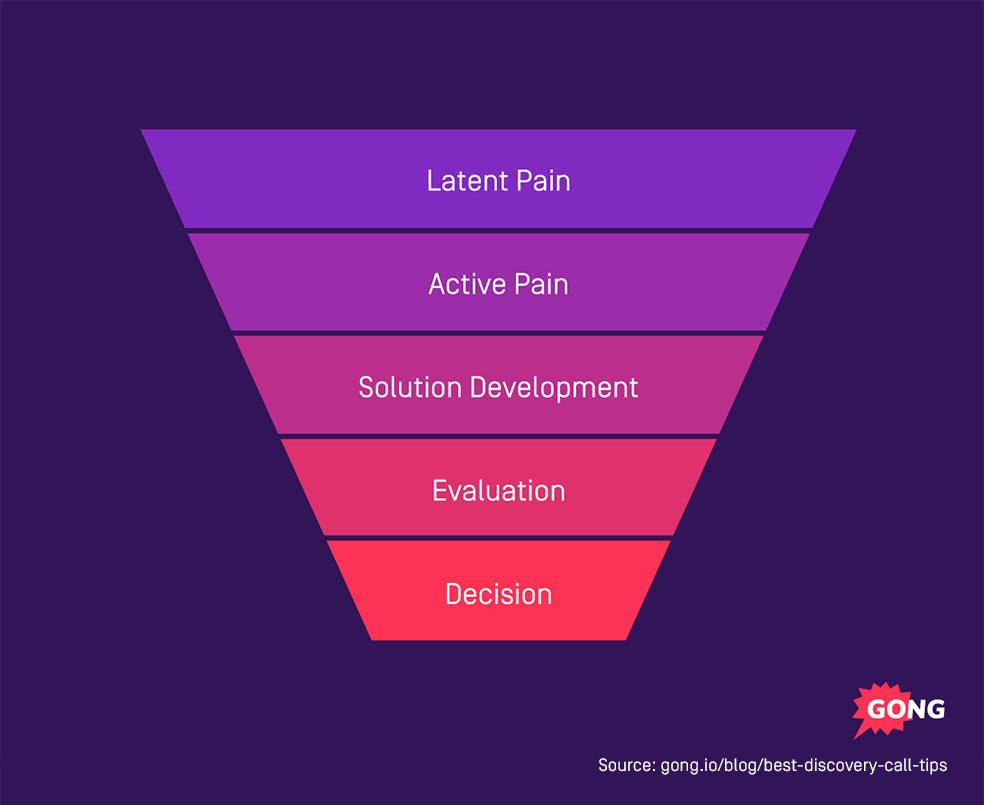
Example: If you learn that your buyer is ACTIVELY evaluating products like yours, don’t start with this kind of question:
What’s your biggest strategic priority for this year?
That’s a diagnostic question. Its purpose is to uncover pain, which is appropriate for the first two stages above.
But your buyer is beyond that stage. They’re evaluating products. So if you start with this question, you’ll irritate them.
Now, I’m not saying DON’T ask that question at all. I’m saying don’t start with it (in this case).
Start with questions that respect the buyer’s journey stage.
In this case, your buyer is in the evaluation stage. So ask them THIS question:
What do you hope to achieve by implementing a solution?
See the difference?
This question matches the buyer’s stage. It’s frictionless. It’s what the buyer wants to talk about.
Once (and only once) you’ve asked that, can you go back to the first question:
- You: What are you hoping to achieve by implementing a solution?
- Buyer: We’re looking to increase sales skills.
- You: Good to know. What’s causing you to prioritize that as an initiative?
- Buyer: Our revenue target has increased, but our marketing budget has not. We’ve got to do more with less. So, better selling skills is a big part of that answer.
Notice the second question in that dialogue. It goes BACK to the beginning stage of the buyer’s journey (pain).
But only once your first question acknowledges that the buyer is already well into their journey. Meet them where they stand.
Key.
THREE: Re-validate everything you uncover
Never assume that what you learned at the beginning of the sales process remains true.
Priorities change. Buyers’ needs are transient.
When things do change, you’better know about it.
If you followed the first tip, you’ll naturally uncover changing buyer priorities.
But if you treat discovery as a “set it and forget it” event, you’ll miss your number.
Here’s how to re-validate your info. Start every sales meeting with this question:
What’s changed since the last time we talked?
FOUR: Phrase your questions to get LONG answers
Don’t you HATE it when buyers answer your questions with one-word responses?
It sucks.
And guess what? According to our data, successful salespeople get LONG answers to their questions:
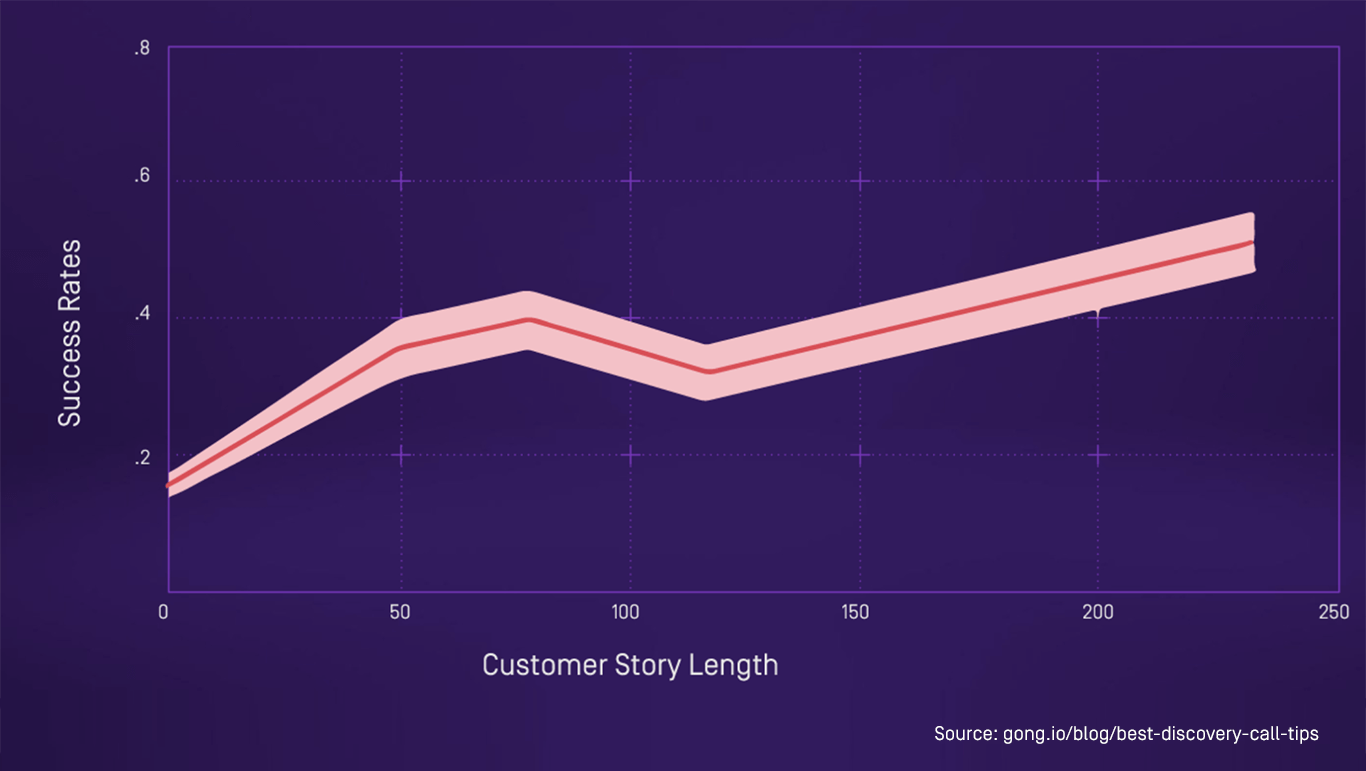
There’s a strong link between buyers’ response lengths and closed deals.
In other words, successful salespeople get longer replies out of their buyers. Their conversations look like this:

Here’s how to do that:
SIGNAL to your buyer that you want a long response. Do that by phrasing your questions the right way.
Start with your basic who, what, when, where, why, or how question.
Got one?
Now, start your question with one of these phrases:
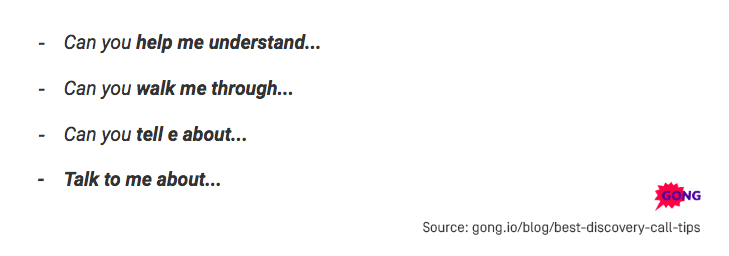
For example:
“What’s your biggest challenge?” becomes “Can you help me understand your biggest challenge?”
This phrasing signals that you want your buyer to answer in depth. You’ll get richer answers that help you close deals.
FIVE: Say these three “magic” words
If you tried the last tip, you’ve got your buyer talking.
That’s GREAT!
Here’s how to keep them talking so you can learn even more.
When they’ve finished responding to your question, do this:
- Repeat the main 1-3 words your customer used in their response.
- Do it with an upward voice tone, like you’re asking a question.
Like this:
- Buyer: We’re losing deals to competitors. Our product is strong, but our reps back peddle when customers ask how we’re different.
- Sales rep: Back peddle?
- Buyer: Yes. They don’t respond with a crisp, strong answer. They stumble. And their answers are inconsistent.
- Sales rep: Inconsistent?
- Buyer: Yeah, that’s another problem we have. I have 70 sales reps running 70 different sales processes …
This technique is called mirroring. Chris Voss popularized it. When you do it right, you open up the floodgates.
The key is to repeat your buyers’ own words back to them. Not your words. And then stop talking.
Pair it with the other techniques you’re learning here. Your buyer will tell you things that help you close the deal.
SIX: Use “commercial-grade” listening
Alrighty! You’ve asked a great question. You’ve kept your mouth shut. And you’ve mirrored your buyer.
Your next step is to label your buyer’s emotions.
When you notice your buyer getting emotional, label that emotion. Complete one of these sentences to do it:
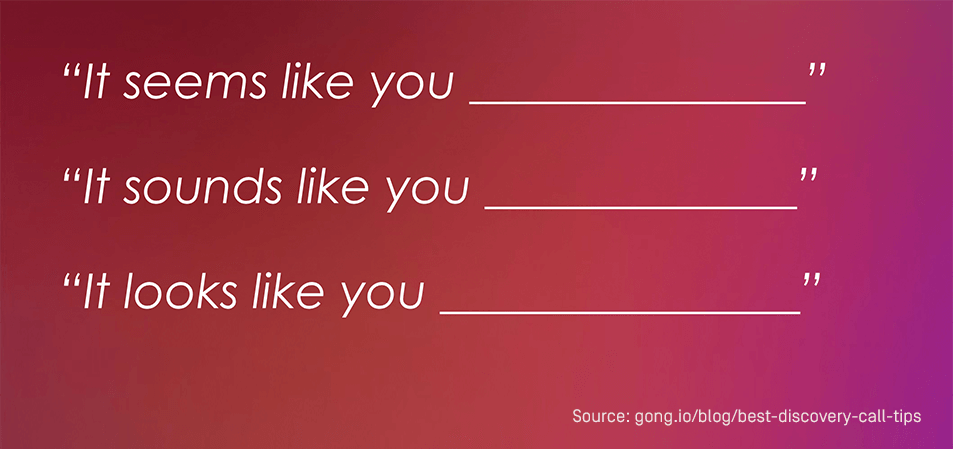
The “blank” is for an accurate label of the emotion your buyer expressed.
This is another Chris Voss technique. An example might sound like this:
- Buyer: It’s a TON of work to onboard new sales reps. Creating the training material is bringing our enablement department to its knees.
- You: It sounds like you feel overwhelmed every time a new onboarding class starts.
- Buyer: I do! I feel a sense of dread every Sunday night before the work week starts.
If you labeled their emotion right, you did something magic. You made your buyer feel deeply understood.
Hint: NO ONE does this.
The key is to shut your mouth after you’ve voiced your label. (Haven’t I said that already!?!)
Let your buyer talk uninterrupted. They’ll love you for it.
If you’re face to face, you’ll notice their body language change dramatically. It will look like you breathed life into them.
SEVEN: Ask questions based on what your buyer just said
Don’t start a new thread with every question.
Go deep. Base your next question on what your buyer just told you.
Your questions should feel spontaneous.
When you DON’T take this approach, it seems like you’re sticking to an annoying line of questioning. It doesn’t feel like a natural conversation.
Instead, ask your questions as a follow-up to what your customer said. It’s what successful salespeople do:
- Sales rep: Can you help me understand where you lose deals most often in your sales process?
- Buyer: After they see a product demo. The buyer gets excited. But then they have the daunting task of getting their VP scheduled for a call with us. Weeks go by. We follow up. And then never hear back.
- Sales rep: Interesting. What would you need to change in order to prevent that from happening?
This is grossly oversimplified. But it illustrates the point.
Your second question shouldn’t start a new thread. It should go deeper into an issue the buyer raised.
Here’s a better explanation than I could hope to give you:
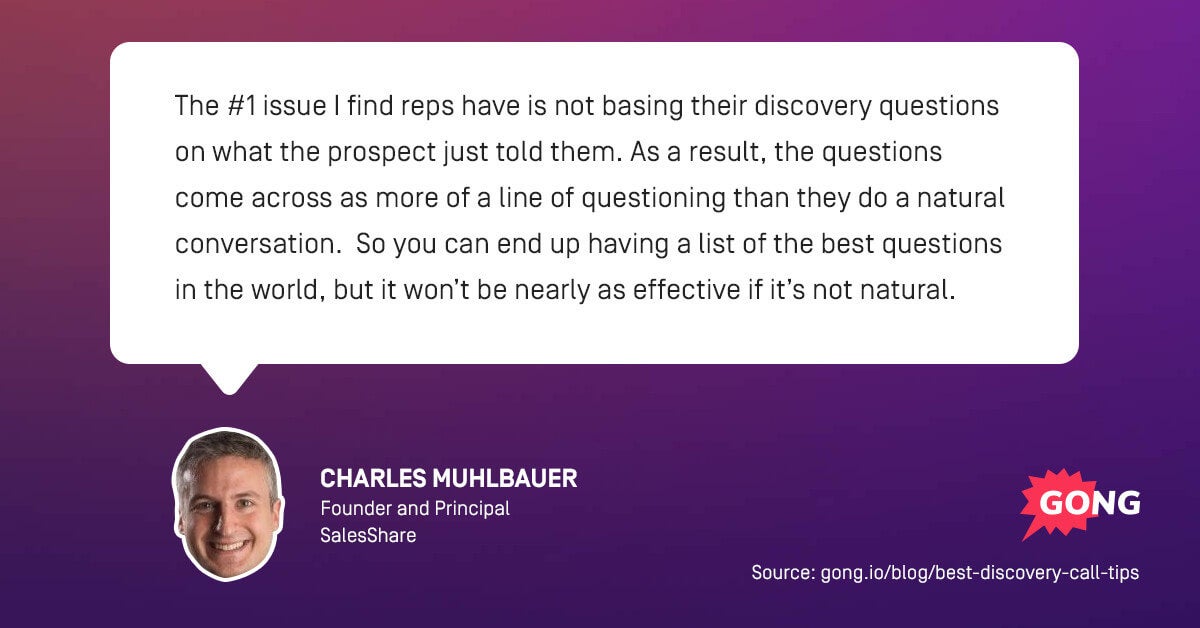
EIGHT: Ask questions only an expert could ask
You know the saying, “There’s no such thing as a dumb question”? It doesn’t apply in sales!
There are plenty of dumb questions. Many of which can bomb your credibility.
The best questions you can ask are ones that only an expert would ask. They’re questions that make your buyer think rather than just recite information.
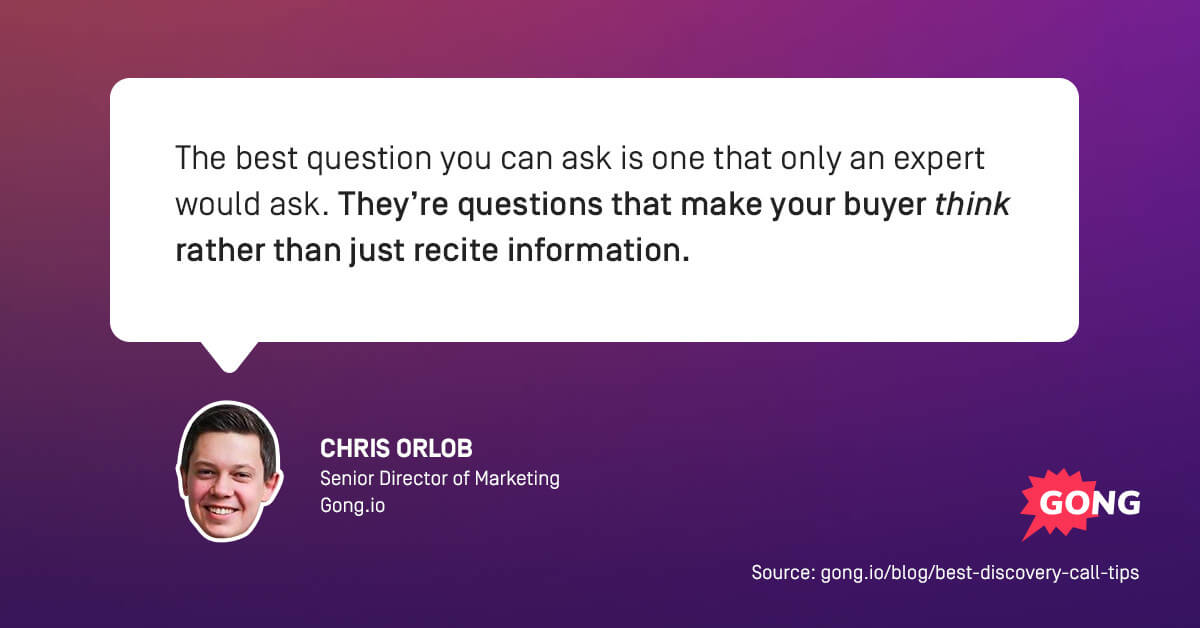
They signal to your buyer that you’re a competent professional they can trust.
Here’s an example.
When I was a sales rep, I often asked this question:
“Can you walk me through your sales process, from when you first generate a new lead, through to a closed deal?”
The wording of that question matters.
It signals a level of seriousness and expertise. You’re about to dig deep with your buyer.
Compare that question with the trite, “What’s your sales process?”
Even though they ask the same thing, only one demonstrates expertise. The other one shows a sophomoric lack of preparation.
NINE: Ask the “sweet spot” number of questions
There’s a sweet spot for how many questions you should ask during a sales call.
That number is between 11 and 14:

If you ask too many questions, the conversation will feel like an interrogation. Too few, and you won’t unearth enough pain.
WARNING! … those numbers don’t apply when you’re selling to a C-Suite executive.
They’re a different animal. They have little patience for too many questions.
When you’re selling to the C-Suite, your win rates drop after asking a small handful of questions:
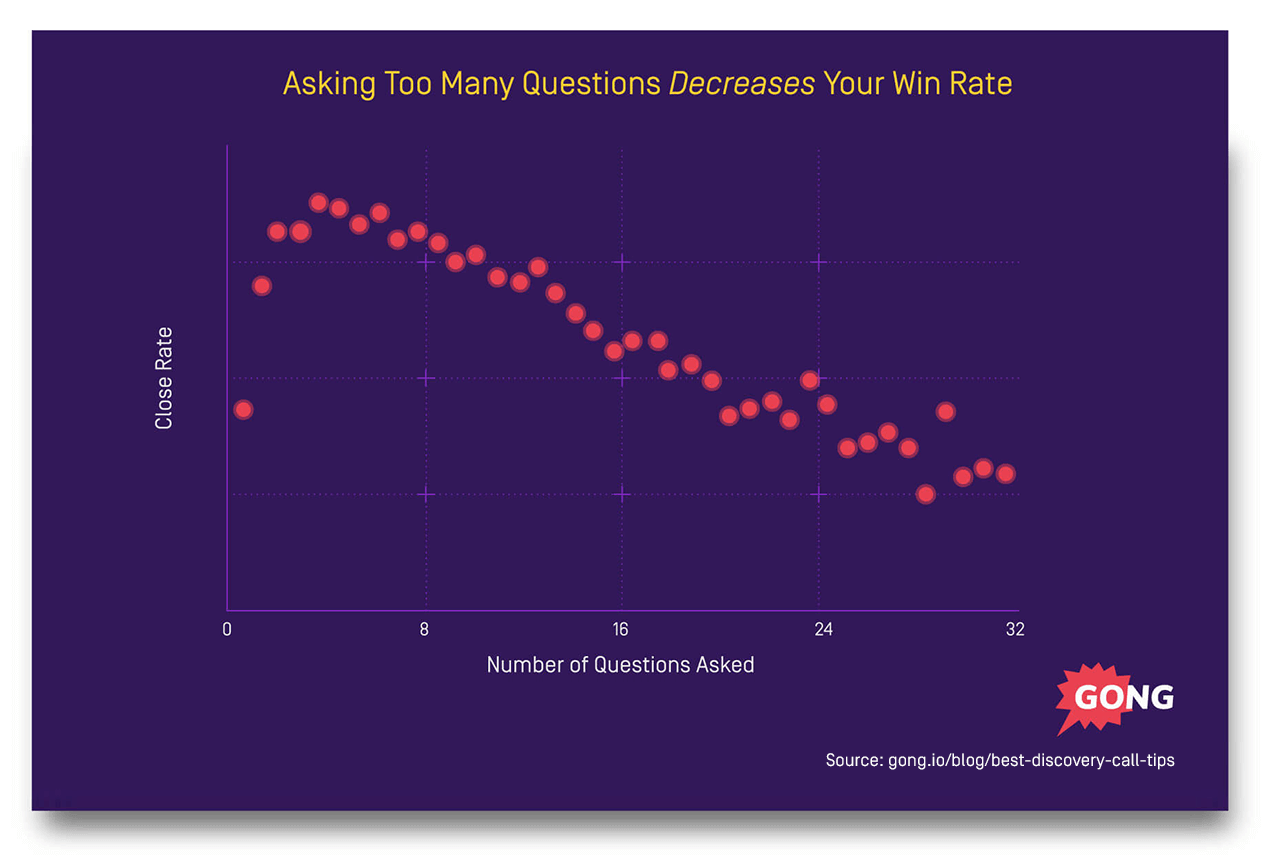
In fact, successful meetings with C-suite executives have only four questions on average. Unsuccessful meetings have eight:
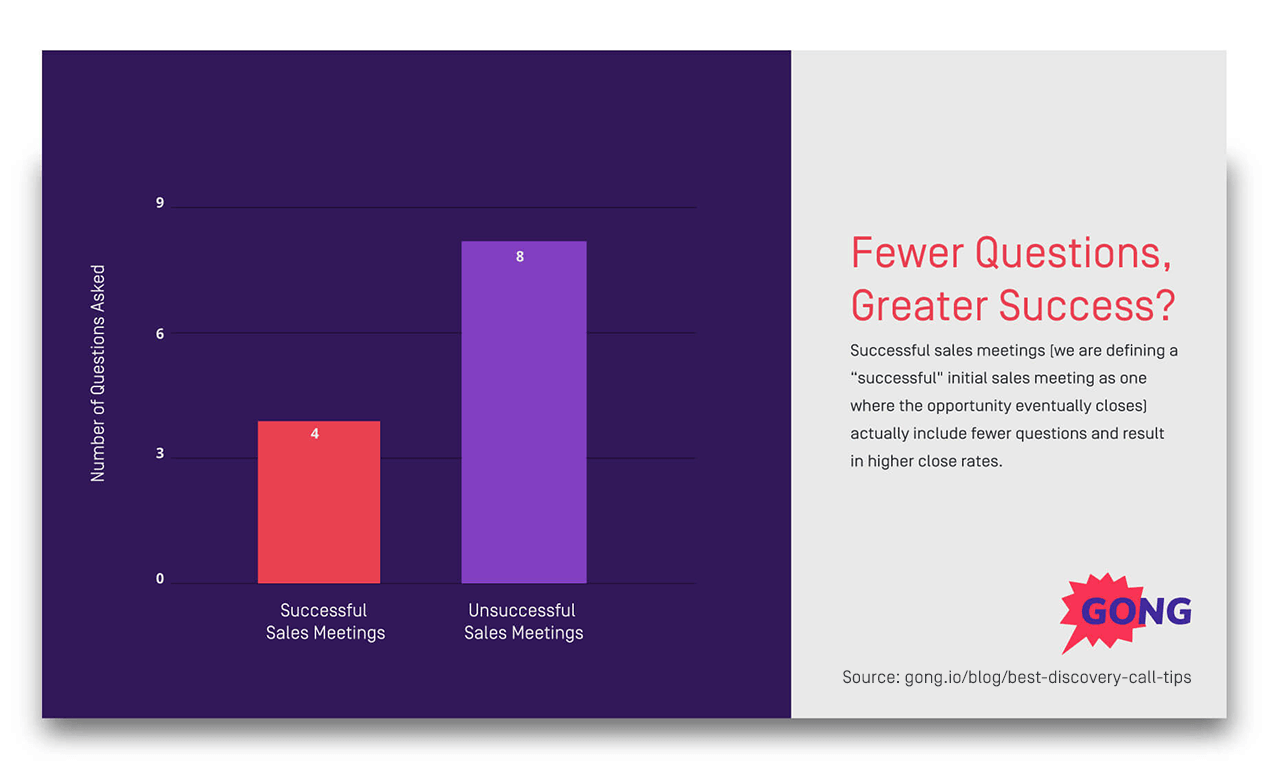
That’s because senior executives have “discovery fatigue.”
By the time they have a meeting with you, they’ve likely been through 2 or 3 discovery calls with other sellers. Answering all those questions feels taxing.
Now, of course, “asking four questions” isn’t the key to selling to the c-suite. That’s a goofy way to interpret this data.
So what should you do when selling to the C-Suite? The answer goes beyond the scope of this post. But I’ve got your back.
Learn how to close deals with the C-Suite in this FREE training video:

TEN: Keep your “talk-to-listen ratio” in the right range
The best salespeople talk for 46% of their sales calls (on average). They leave 54% of the talking time to the customer.
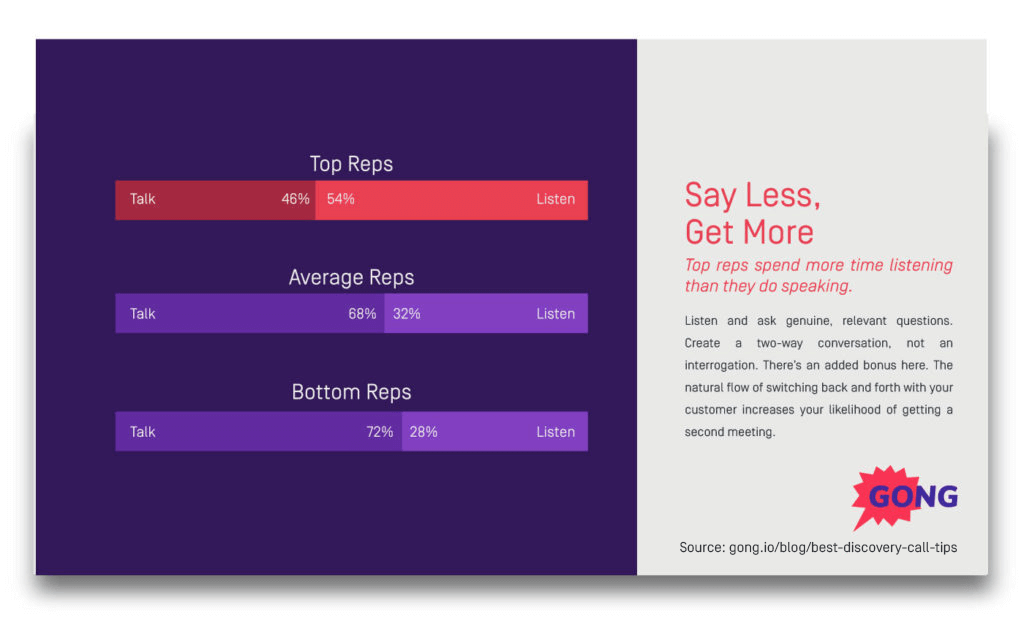
Maintaining the right talk-to-listen ratio is so obvious that it should be the first tip.
So, why isn’t it?
Because it’s a byproduct of doing everything else right.
Talking for 46% of a call isn’t going to magically help you close deals.
But if you follow the other tips in this post, you’ll end up with this ratio (more or less).
At the very least, stay in the recommended RANGE.
Don’t go ABOVE 65%, which is where you start to lose deals.
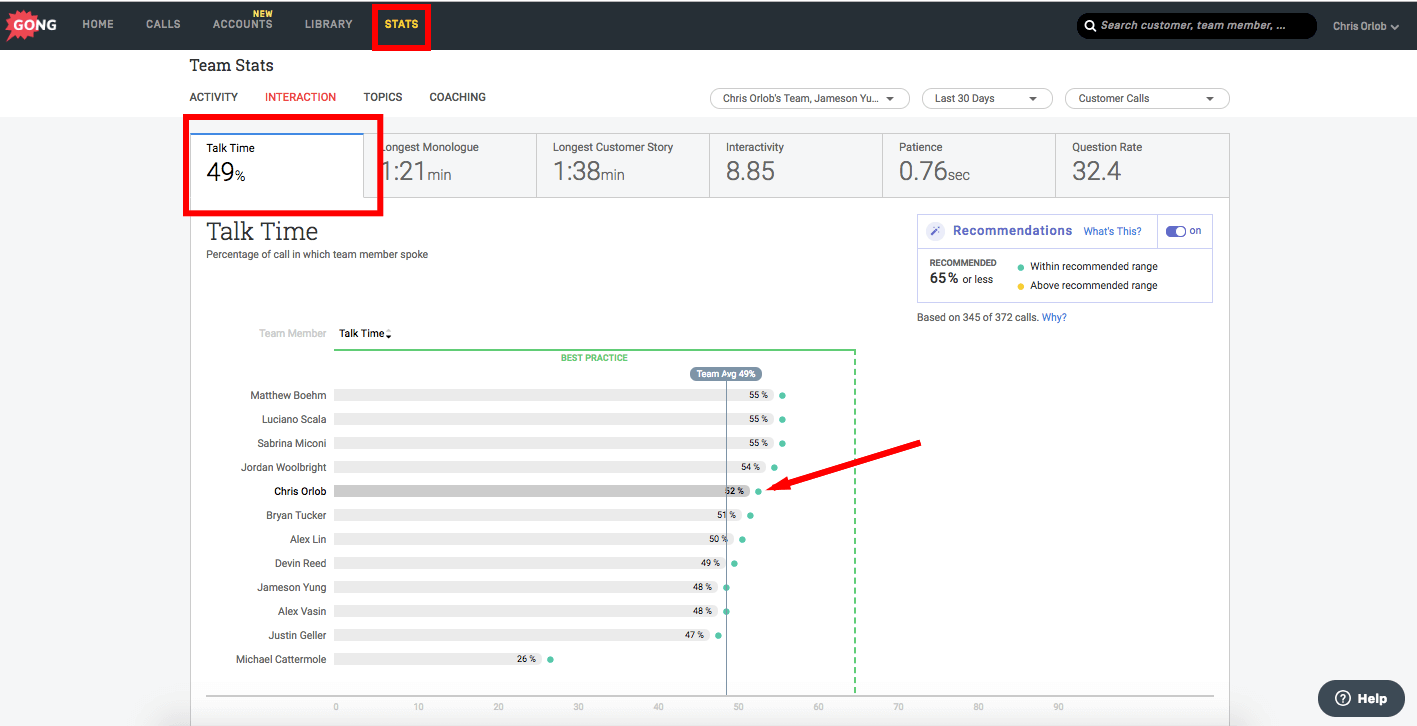
Keep tabs on this stat. It matters, especially when it gets too high.
ELEVEN: Turn on your webcam
Why is this is a DISCOVERY call tip?
Because it’s more important to turn on your webcam during discovery calls than during other types of calls.
Why? Because other types of calls already have a visual backdrop for the conversation:
- Demo calls have a product demo
- Presentations have a visual slide deck
- Etc.
Discovery calls are mano y mano: you and the buyer.
If you don’t have your webcam on, your buyer has nothing to look at. And they’re more likely to grow tired of your questions (or act rudely).
Closed deals involve using webcams 41% more often than lost deals:

When the buyer sees your face, the call becomes more human. More conversational . It brings life to everything you say.
It helps your buyer believe you’re driven by curiosity, rather than checking boxes in a to-do list of questions.
Here’s what to do next…
PHEW!
That brings us to the end.
Do you want the tips you learned here to stick?
Download our (FREE) cheat sheet.
It summarizes the key points of great discovery calls.
By the way, I have a confession to make…
I have three BONUS discovery tips for you…
And they. Are. Powerful.
These three bonus tips will give you a MASSIVE advantage. No one is doing them.
Why didn’t I include them here?
I want to keep them “secret” (sort of…)
That’ll extend their shelf life.
“Inner circle” members only :)
So, I’m only making them available to people who sign-up for the cheat sheet.
Do that here, and you’ll get the three bonus tips via email in the next few days:

Listen: I’LOVE to have a conversation with you.
I have a burning question I want your take on:
Do you think discovery and demos should happen on the same call or separate calls?

Content Author
Chris Orlob is the Co-Founder and CEO of Pclub.io, a leading sales training platform designed to help sales professionals accelerate their revenue growth. He is best known for his pivotal role at Gong, where he helped scale the company from $200,000 to $200 million in ARR, contributing to a $7.2 billion valuation. During his tenure at Gong, Chris led the creation of Gong Labs and excelled in various go-to-market roles. Today, through Pclub.io, he leverages his deep expertise in sales and revenue operations to coach over 11,000 SaaS sellers.
Discover more from Gong
Check out the latest product information, executive insights, and selling tips and tricks, all on the Gong blog.



